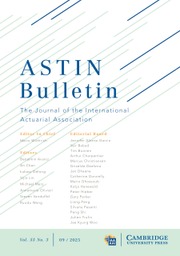No CrossRef data available.
Article contents
Optimal design of fixed and variable costs in peer-to-peer insurance with heterogeneous risk
Published online by Cambridge University Press: 22 September 2025
Abstract
This paper examines the optimal design of peer-to-peer (P2P) insurance models, which combines outside insurance purchases with P2P risk sharing and heterogeneous risk. Participants contribute deposits to collectively cover the premium for group-based insurance against tail risks and to share uncovered losses. We analyze the cost structure by decomposing it into a fixed premium for outside coverage and a variable component for shared losses, the latter of which may be partially refunded if aggregate losses are sufficiently low. We derive closed-form solutions to the optimal sharing rule that maximizes a mean-variance objective from the perspective of a central or social planner, and we characterize its theoretical properties. Building on this foundation, we further investigate the choice of deposit for the common fund. Finally, we also provide numerical illustrations.
Information
- Type
- Research Article
- Information
- ASTIN Bulletin: The Journal of the IAA , Volume 55 , Special Issue 3: Risk Sharing , September 2025 , pp. 721 - 746
- Copyright
- © The Author(s), 2025. Published by Cambridge University Press on behalf of The International Actuarial Association

